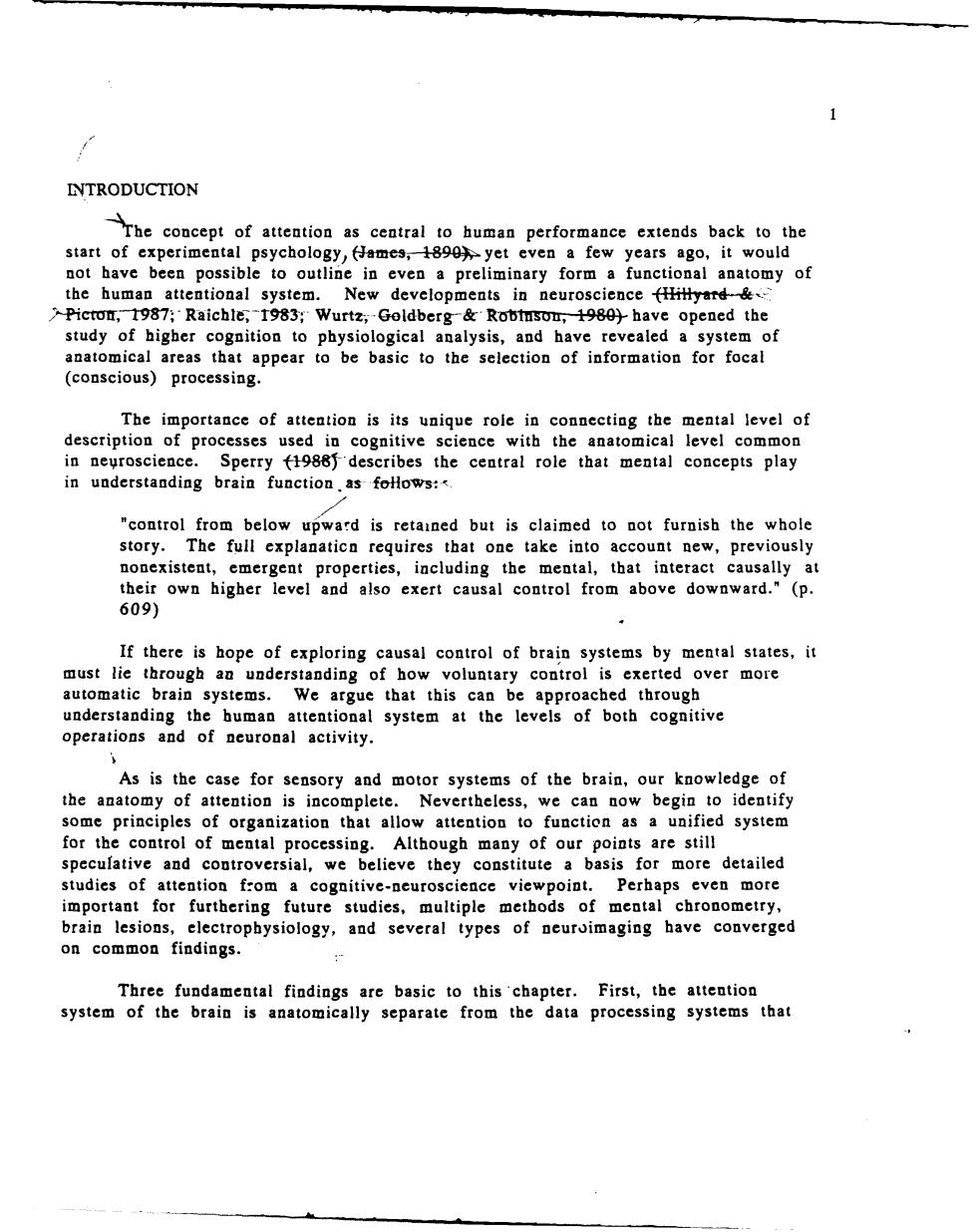正在加载图片...

INTRODUCTION The concept of attention as central to human performance extends back to the start of experimental psychology,(ames,1890)yet even a few years ago,it would not have been possible to outline in even a preliminary form a functional anatomy of the human attentional system.New developments in neuroscience fHiHyard& Picton,1987:Raichle;-1983:Wurtz:-Goldberg&Robtnsom 1980)have opened the study of higher cognition to physiological analysis,and have revealed a system of anatomical areas that appear to be basic to the selection of information for focal (conscious)processing The importance of attention is its unique role in connecting the mental level of description of processes used in cognitive with the anate mical level common in neuroscience. Sperry (1988)de cribes the central role that mental concepts play in understanding brain function as fo "control from below story. Th full exp es,including the theisown higher level exert caua conto from above dowaward. ergen men (P 609) If there is hope of exploring causal control of brain systems by mental states,it must lie automatic ayeanirggglralege9peg6g6eraore th understanding the human attentional system at the levels of both cognitive operations and of neuronal activity. As is the case for sensory and motor systems of the brain,our knowledge of the anatomy of attention is incomplete.Nevertheless,we can now begin to identify some principles of organization that allow attention to function as a unified system for the control of mental processing.Although many of our points are still speculative and controversial,we believe they constitute a basis for more detailed studies of attention from a cognitive-neuroscience viewpoint.Perhaps even more important for furthering future studies,multiple methods of mental chronometry, brain lesions,electrophysiology,and several types of neurvimaging have converged on common findings. Three fundamental findings are basic to this'chapter.First,the attention system of the brain is anatomically separate from the data processing systems that / INTRODUCTION - lrhe concept of attention as central to human performance extends back to the start of experimental psychology, (,&mes,-44W,90 yet even a few years ago, it would not have been possible to outline in even a preliminary form a functional anatomy of the human attentional system. New developments in neuroscience '-'. 2 -Picroa,--1-9S7,- Raichk,-t983; Wurtz-Goldberg-& R - have opened the study of higher cognition to physiological analysis, and have revealed a system of anatomical areas that appear to be basic to the selection of information for focal (conscious) processing. The importance of attention is its unique role in connecting the mental level of description of processes used in cognitive science with the anatomical level common in nearoscience. Sperry tV98 'describes the central role that mental concepts play in understanding brain function. as- foHows: "control from below upward is retained but is claimed to not furnish the whole story. The full explanaticn requires that one take into account new, previously nonexistent, emergent properties, including the mental, that interact causally at their own higher level and also exert causal control from above downward." (p. 609) If there is hope of exploring causal control of brain systems by mental states, it must lie through an understanding of how voluntary control is exerted over more automatic brain systems. We argue that this can be approached through understanding the human attentional system at the levels of both cognitive operations and of neuronal activity. As is the case for sensory and motor systems of the brain, our knowledge of the anatomy of attention is incomplete. Nevertheless, we can now begin to identify some principles of organization that allow attention to function as a unified system for the control of mental processing. Although many of our points are still speculative and controversial, we believe they constitute a basis for more detailed studies of attention from a cognitive-neuroscience viewpoint. Perhaps even more important for furthering future studies, multiple methods of mental chronometry, brain lesions, electrophysiology, and several types of neuroimaging have converged on common findings. . Three fundamental findings are basic to this chapter. First, the attention system of the brain is anatomically separate from the data processing systems that